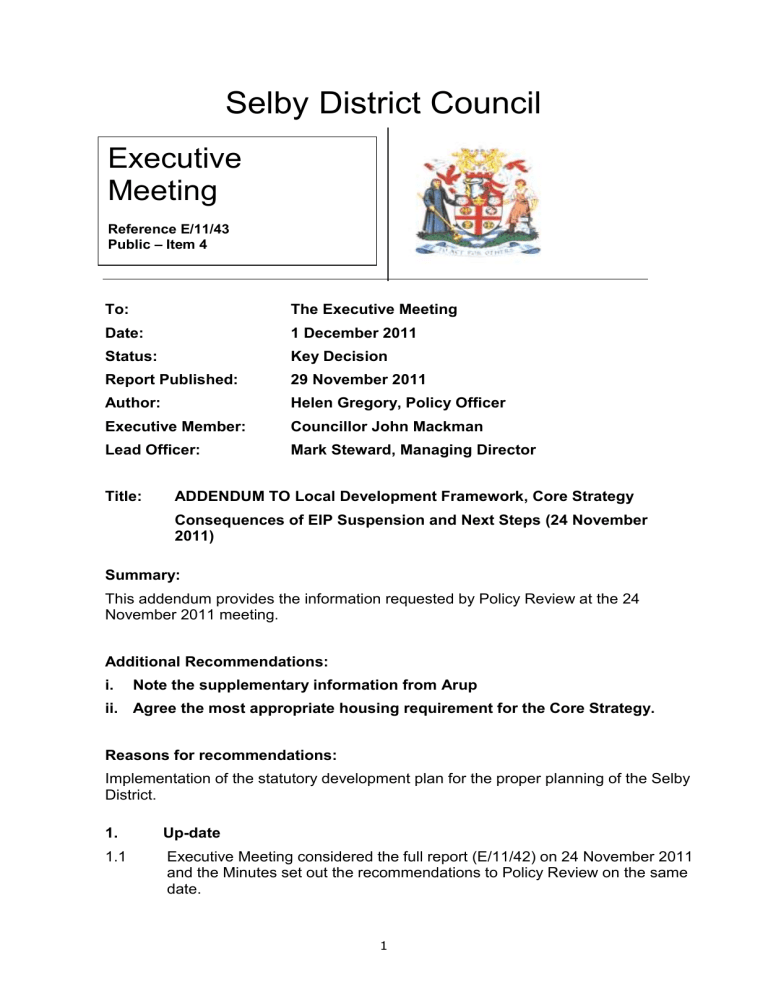Report to follow - E/11/43

Selby District Council
Executive
Meeting
Reference E/11/43
Public – Item 4
To:
Date:
Status:
The Executive Meeting
1 December 2011
Key Decision
Report Published:
Author:
Executive Member:
29 November 2011
Helen Gregory, Policy Officer
Lead Officer:
Councillor John Mackman
Mark Steward, Managing Director
Title: ADDENDUM TO Local Development Framework, Core Strategy
Consequences of EIP Suspension and Next Steps (24 November
2011)
Summary:
This addendum provides the information requested by Policy Review at the 24
November 2011 meeting.
Additional Recommendations: i. Note the supplementary information from Arup ii. Agree the most appropriate housing requirement for the Core Strategy.
Reasons for recommendations:
Implementation of the statutory development plan for the proper planning of the Selby
District.
1.
1.1
Up-date
Executive Meeting considered the full report (E/11/42) on 24 November 2011 and the Minutes set out the recommendations to Policy Review on the same date.
1
2.3
3.
3.1
1.2
1.3
1.4
2.
2.1
2.2
3.2
3.3
Policy Review ( Report PR/11/9) considered the issues and proposed a number of changes to the recommendations (see Draft Minutes at Appendix 1 attached).
The Council has now received the further information from Consultants (Arup) regarding the evidence for the sustainability of housing growth on a range of
450 to 465 dwellings per year over the Plan period
Appendix 2 outlines the consultant’s justification for the recommendation that
450 dwellings per year or annum (dpa) over the plan period is the most robust figure to use and highlights the pros and cons if Executive want to propose an alternative figure of 465 dpa..
Revised Figures Implications
The comparison of the overall scale of housing requirement over the plan period for the different levels are as follows:
440 dw X 16 yrs = 7040 dw (Submission Core Strategy May 2011)
450 dw X 16 yrs = 7200 dw
465 dw X 16 yrs = 7440 dw
Tables 3 and 4 and Appendix 8 of the 24 November 2011 Executive Meeting report, show how the 450 dpa figure would change the Core Strategy as submitted. There would be no change to the overall distribution strategy
(other than the highlighted balance between the two Local Service Centres).
Appendix 3 of this report illustrates the revised figures if the alternative figure of 465 dpa was used.
Decision Required
In order to progress the Core Strategy in accordance with the prescribed timetable for the suspension of the EIP, the Executive Meeting must decide on the most appropriate housing figure to seek to ensure that the Core
Strategy is found sound by the Inspector following the reconvened EIP.
The factors that councillors must bear in mind are that the decision must be: o Based on robust evidence o Be defendable in front of third parties o Deliverable
The main Executive report (E/11/42 on 24 November 2011) sets out in more detail the ongoing work which is being undertaken to establish land availability, deliverability, settlement capacity and sustainability tests. At this stage it is believed that the increase in housing numbers (to 450 or 465 dpa) can be accommodated within the established strategy in line with the Core
Strategy Vision, Aims and Objectives. The Key Findings of this work will be
2
4.
4.1
4.2
4.3
4.4
4.5 available for 13 December 2011 to enable the Full Council to make the final decision based on the best evidence. The documented evidence base will be available during the consultation period and in advance of the reconvened
EIP.
Officer Comments
The further paper from Arup (Appendix 2) sets out in Section 5 that because
465 is very similar to 450 it would be reasonably robust given the current economic circumstances and future prospects. However past completion rates should not be the primary basis for planning for future housing growth.
Further, although a plausible case could be put forward for a higher figure than the 450 dpa recommended for example taking account of under provision/delivery in neighbouring authorities; this would be contrary to the
Core Strategy principles of increasing economic self containment and reducing out-commuting.
As outlined above and in the main report, the decision must be made on credible evidence. It is also worth noting that the housing requirement is an annual minimum target.
The Arup paper(s) also set out that there is a case for planning for a rate of housing delivery that is lower in the first five years. This is in the light of the evidence available leading to a cautious view being taken regarding economic recovery.
A suggested approach for 450 dpa might be (7200 dw over the plan period):
1 st 6 years 2011
– 2017
400 dpa = 2400 dw
2 nd 10 years 2018
– 2027
480 dpa = 4800 dw
A suggested approach for 465 dpa might be (7440 dw over the plan period):
1 st 6 years 2011
– 2017
400 dpa = 2400 dw
2 nd 10 years 2018 – 2027 510 dpa = 5100 dw
Which would equate to a rounded figure of 7500 dwellings.
Contact Details: Helen Gregory, Policy Officer
Appendices:
Appendix 1 Policy Review Draft Minutes 24 November 2011
Appendix 2 Arup Paper Update
Appendix 3 Illustration of 465 dpa
3
Appendix 1 Policy Review Draft Minutes 24 November 2011
Minutes
Policy Review Committee
Venue:
Date:
Present:
Committee Room
24 November 2011
Councillor M Jordan (Chair), Councillor R Musgrave,
Councillor R Packham, Councillor I Reynolds and
Councillor Mrs A Spetch
Apologies for Absence: Councillor Mrs E Metcalfe, Councillor R Sweeting,
Councillor I Nutt and Councillor Davis
Also Present: Councillor J Mackman and Councillor Mrs G Ivey (for part of the meeting)
Officers Present: Jonathan Lund, Deputy Chief Executive; Michelle Sacks,
Solicitor to the Council; Eileen Scothern, Business
Manager; Helen Gregory, Policy Officer and Richard
Besley, Democratic Services Officer
24. Declarations of interest
Following advice from the Deputy Chief Executive and in accordance with the
Constitution and the Councillor Code of Conduct, Councillors Mackman and Mrs
Ivey declared a prejudicial interest in item in 25 (The Core Strategy) by virtue of the fact that they were Executive members and had been present when the decision under scrutiny by the Policy Review Committee was made.
25. Report PR/11/9 – Core Strategy – Key Decision
The Chair presented report PR/11/9 which set out the Inspe ctor’s concerns in respect of the Selby District Core Strategy from the
Examination in Public (EIP) and the implications for the Council.
4
The Chair asked the Business Manager to summarise the discussions from the Executive meeting which had taken place earlier in the morning.
The Business Manager informed the Committee that the Executive had discussed the three main topics that prompted the adjournment of the EIP, these were:
The overall scale of housing development over the plan period;
The scale of housing and employment development proposed for
Tadcaster and the implications for the Green Belt;
The strategic approach to Green Belt issues.
Executive Member Councillor Mackman detailed a minor amendment made by the Executive to the Green Belt Policy. He also advised Policy
Review Committee of an amendment made by the Executive to clarify the emphasis to deliver housing in the Tadcaster area.
The Committee heard that the Executive discussed the quantum of housing development over the plan period. Discussion had focused on the
450 houses per annum planned housing growth as recommended in the detailed report submitted by the Council’s consultants.
Policy Review supported the Executive’s request that the consultants be asked to provide further evidence to substantiate the recommendations and advice on the sustainability of housing growth figures in a range between 450 and 465 per annum.
In compliance with the Code of Conduct, and there being no further questions for the Executive members, Councillors Mackman and Mrs Ivey left the meeting.
Councillor Packham raised a number of queries regarding the proposed housing increase for Tadcaster. He informed the Committee of the debate at a recent Sherburn Parish Council meeting regarding any potential increased housing numbers for the area. The Business Manager clarified the position of the Core Strategy in relation to the Localism Act which had recently received royal accent.
The Committee discussed the decisions made by the Executive. The Chair proposed that the changes to the Core Strategy, outlined at recommendation (iii) in the Executive minutes, should be approved by the
Executive acting collectively rather than an individual Executive member. It was agreed to make this recommendation to the Executive.
Councillor Packham proposed that in respect of Executive recommendation (vi) the words “as the preferred option” be removed in favour of “to accommodate the shortfall in Tadcaster”. It was agreed to make this recommendation to the Executive.
5
RESOLVED:
(i) The note the report;
(ii) To support the Executive in asking the Council’s consultants to provide evidence of the sustainability of housing growth on a range of
450 to 465 dwellings;
(iii) To request that the Executive amend the recommendation to read:
More detailed policy proposals and Proposed Changes to the Core
Strategy be developed for approval by the Executive, taking into account the Green Belt Policy as amended;
(iv) To request that the Executive amend the recommendation regarding housing at Tadcaster to read:
In respect of the shortfall of housing in Tadcaster, to approve Plan A to accommodate the shortfall in Tadcaster.
The meeting closed at 2.25pm
6
Appendix 2 Arup Paper Update (29 November 2011)
1. Selby District Housing Requirements – Supplementary Paper
Introduction
This is a supplementary note to the Arup report for Selby District Council, Scale of
Housing growth in Selby . This note has been produced in response to points made by
Selby District Council Members at the committee meeting on 24 November 2011. Our understanding is that Members expressed the following concerns regarding the annual housing requirement figure of 450 net additional dwellings recommended in the Arup report:
The figure of 450 is similar to the RSS figure of 440 – have Arup considered the issue of the appropriate housing figure robustly and from first principles?
Should not the most recent evidence, particularly the 2008-based household projections, be used as the basis for identifying future housing growth requirements?
To what extent is the recommended figure of 450 based on a cautious view of future economic performance, and what would be the implications of economic recovery and faster growth in the future?
What would be the pros and cons of a figure of 465 net additional dwellings per anum?
Given the content of the Inspector’s letter when suspending the Inquiry into the
Core Strategy, what are the risks to Selby District Council recommending a figure of
450?
This note considers each of these points.
2. Evidence Base and Methodology
The figure of 450 is similar to the RSS figure of 440 – have Arup considered the issue of the appropriate housing figure robustly and from first principles?
We are confident that we have undertaken a robust and rigorous review of all of the available sources of evidence on future housing growth requirements. We have considered carefully, from first principles, the various sources of evidence on population growth, household formation, the housing market, housing completions, housing land availability, and the economy.
Our conclusions are our independent professional opinion and judgement, which we have reached on the basis of the available sources evidence and our assessment of the robustness and relevance of the sources. We have not built a quantitative model to identify the most appropriate housing growth requirement. Whilst it would be possible to do this given sufficient time and budget, in our experience the outputs from such models depend greatly on the professional judgements made on the most appropriate inputs.
The reason our recommendation of a figure of 450 net additional dwellings per annum is similar to the RSS figure of 440 is because, in our professional opinion, the 2004 based CLG household projections provide the most appropriate basis for planning for
7
future housing growth. The RSS housing growth requirements also used the 2004-based
CLG household projections as the starting point for identifying future housing growth.
Our 40 page report is thorough and comprehensive. The project team have discussed the conclusions internally with senior technical staff within Arup’s planning practice.
We would be willing to defend our work at the Inquiry should we be requested and commissioned to do so.
3. Robustness of the 2008-based household projections
Should not the most recent evidence, particularly the 2008-based household projections be used as the basis for identifying future housing growth requirements?
Our professional opinion is that the 2008-based CLG household projections do not provide the most appropriate basis for planning for housing growth in the current economic circumstances and future economic prospects.
The CLG household projections are based on ONS population projections, which generally project forward the trends observed in the five year period prior to the base year. The five years prior to 2008 were a period of economic boom and substantial immigration. The economic conditions today and those of the past 3 years are very different, with recent trends and future forecasts being for recession or very slow growth. In particular, weak economic growth will affect migration trends. Migration assumptions (which are influenced significantly by the economy) are a major factor in the population forecasts, and therefore also the household projections.
We are mindful in the advice in PPS3 that that Local Planning Authorities should take into account the
“Government’s latest published household projections”.
However we note that PPS3 goes on to say that account should also be taken of “the needs of the regional economy, having regard to economic growth forecasts.”
Our view is that most recent economic forecasts, which indicate a slow recovery to pre-recession levels of employment and economic growth, mean there is a reasonable case for not using the
2008 based forecasts. This view is supported by the fact that the North Yorkshire
Strategic Market Assessment produced recently (September 2011) sets out a scenario for Selby based on up-to-date economic forecasts of only 403 net additional dwellings per annum.
Our conclusion that the 2008-based projections are not the appropriate basis for planning for housing growth is in line with other similar to the similar work we undertook for the City of York Council, and the conclusions reached by the City of
York on the most appropriate basis to plan for housing growth in their draft Core
Strategy.
Our view is that the 2004-based projections provide a more appropriate basis for planning for housing growth, because the economic conditions and migration patterns in the five year period up to 2004 were more similar to the current circumstances.
Evidence on past housing completions provides further weight to the conclusion that the
2004 based household projections form the most appropriate basis for identifying future requirements. The average housing completion rate between 2003/4 and 2010/11 was
465 per annum, broadly in line with the 2004 based household projections of 450 net additional dwellings per annum. The 2008 based projections are for 550 net additional dwellings per annum, but annual completions only exceeded 500 the three years from
2005/6 to 2007/8 which were at the height of the housing market boom.
8
In reaching our conclusion we have assumed that Selby will not accommodate housing growth generated by neighbouring authorities, as to do so would undermine one of the central policy principles of the draft Core Strategy.
4. Assumptions on future economic change
To what extent is the recommended figure of 450, based on a cautious view of future economic performance, and what would be the implications of economic recovery and faster growth in the future?
The recommendation of an annual housing growth requirement of 450 net additional dwellings is based on our view that the economic recovery is likely to be slow, with pre recession employment levels not returning until at least 2017. This view is supported by the latest available economic forecasts from the Regional Econometric Model, and it should be noted that these most recent forecasts predate the recent worsening of the
Eurozone crisis. The OECD is predicting now that the UK will experience a “doubledip recession”, and that recovery from this will be slow. Our view is that there is unlikely to be rapid economic an employment growth in the next 5 years, and this is supported by most of the available evidence, and by most economic commentators.
Given the extent of current economic uncertainty, our view is that there is a case for considering planning for a rate of housing delivery that is lower in the first five years of the plan period than it is in the period from 6 to 20 years, with this being reviewed in due course once future economic and demographic prospects become clearer.
5. Robustness of planning for 465 net additional dwellings per annum
What would be the pros and cons of a figure of 465 net additional dwellings per annum?
An annual housing growth figure of 465 is similar to our recommended figure of 450.
Therefore our view is that a figure of 465 would be reasonably robust given current economic circumstances and future prospects.
The basis for a figure of 465 is the long-term average completion rate. Our view is that past evidence on completions is useful to sense-check planned housing growth requirements derived from household projections, but should not be the primary basis for planning for housing growth. Evidence on completions can be lumpy (as a result of large schemes being delivered in any one year) and is dependent on the quality of monitoring by the local planning authority. If completions data is used as the primary basis for identifying a future housing growth requirement, some housebuilders are likely to argue a different range should be used, or that there has been undercounting of completions.
It would be possible to make a plausible case for an increase on the recommended figure of 450 net addition dwellings per annum in order to take into account underprovision or under-delivery in neighbouring authorities. However this would not be appropriate given the policy principle of the draft core Strategy to increase the economic self containment of Selby District and to reduce levels of out-commuting.
9
6. Risks
Given the content of the Inspector’s letter when suspending the Inquiry into the
Core Strategy, what are the risks of SDC recommending a figure of 450?
We are confident that the recommended figure of 450 net additional dwellings per annum is robust, evidence based, and appropriate in the current circumstances. However we appreciate that this position is not without risks for Selby District Council.
Housebuilders and their representatives will make a forceful case that the most recent household projections should provide the basis for identifying a future housing growth requirement, and they will cite PPS3 in support of this position. Our view is that PPS3 provides sufficient flexibility to depart from the most recent household projections, particularly given recent significant changes in the economy. However, there is a danger that the Inspector may not agree with our interpretation of PPS3.
There is also a danger that housebuilders might claim that the cautious view of future economic growth prospects that underpin the figure of 450 net additional dwellings per annum are not commensurate with the economic assumptions on which future employment land requirements have been based.
10
Appendix 3 Illustration of 465 dpa
REVISED Table 3 USING 465 DW
% dpa Minimum require ’t
16 yrs total
2011-2027
Existing
PPs
31.03.11*
New
Allocations needed
(dw)
% of new allocations
Selby**
Sherburn
Tadcaster
Designated
Service
Villages
51
11
7
29
237
51
33
135
3792
816
528
2160
1145
74
140
286
2647
742
388
1874
47
13
7
33
Secondary
Villages****
2
Total 100
9
465
144
7440****
170
1815
-
5651
-
100
* Commitments have been reduced by 10% to allow for non-delivery.
** Corresponds with the Contiguous Selby Urban Area and does not include the adjacent villages of
Barlby, Osgodby, Brayton and Thorpe Willoughby.
*** Contribution from existing commitments only.
**** Target Land Supply Provision (465 dwellings per annum x 16 years)
11
REVISED Table 4 if Using 465 dpa
Comparative Change to Housing Requirement by Settlement Hierarchy
Selby
Sherburn
Tadcaster
Designated
Service
Villages
Overall
Require ment
Current
Current
Core
Strategy
CP2
%
(440 dpa)
New
Allocations
Overall
Require ment
NEW
%
New
Allocations
Required
450 dpa
Difference between
450 and
440
New
Allocations
Required
465 dpa
Difference between
465 and
440
51
9
9
28
2336
498
457
1573
51
11
7
29
2527
718
364
1776
+ 191
+ 220
- 93
+ 203
Secondary
Villages
3 0 2 0 0
TOTAL 4864 5385 + 521
DISTRICT-
WIDE
See over for Illustration of CP2 if using 465 dpa
2647
742
388
1874
0
5651
+ 311
+ 244
- 69
+ 301
0
+ 787
12
Policy CP2 The Scale and Distribution of Housing
A. Provision will be made for the delivery of 465 dwellings per annum and associated infrastructure in the period up to 2027. After taking account of current commitments, housing land allocations will be required to provide for a target of 5700 dwellings between 2011 and 2027, distributed as follows:
Selby**
Sherburn
Tadcaster
Designated
Service
Villages
Secondary
Villages****
%
51
11
7
29
2 dpa
240
50
35
130
10
Minimum require ’t
16 yrs total
2011-2027
3800
820
530
2150
140
Existing
PPs
31.03.11*
1150
70
140
290
170
New
Allocations needed
(dw)
2700
750
390
1860
-
% of new allocations
47
13
7
33
-
Total 100 465 7440**** 1820 5700 100
* Commitments have been reduced by 10% to allow for non-delivery.
** Corresponds with the Contiguous Selby Urban Area and does not include the adjacent villages of
Barlby, Osgodby, Brayton and Thorpe Willoughby.
*** Contribution from existing commitments only.
**** Target Land Supply Provision ( 465 dwellings per annum x 16 years)
B. In order to accommodate the scale of growth required at Selby
1000 dwellings will be delivered through a mixed use urban extension to the east of the town, in the period up to 2027, in accordance with Policy CP2A. Smaller scale sites within and/or adjacent to the boundary of the Contiguous Urban Area of Selby to accommodate a further 1700 dwellings will be identified through a
Site Allocations DPD.
C. Options for meeting the more limited housing requirement in
Sherburn in Elmet and Tadcaster will be considered in Site
Allocations DPD.
13
D. Allocations will be sought in the most sustainable villages
(Designated Service Villages) where local need is established through a Strategic Housing Market Assessment and/or other local information. Specific sites will be identified through Site
Allocations DPD.
14







